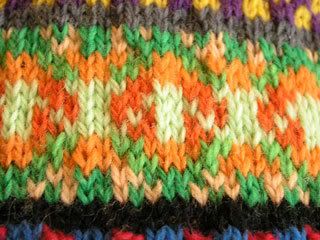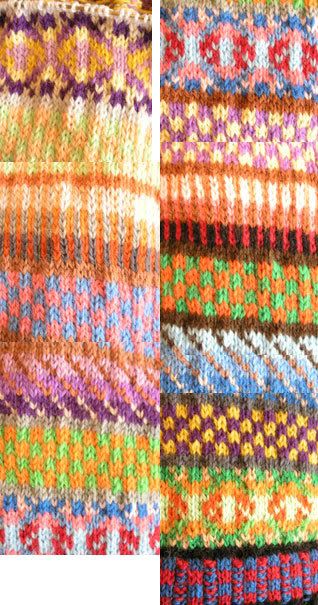
First, as you can see, it isn't all that perfectly flat when you see it closeup. It will, however, be perfect once it's blocked.
But the real point is that this sweater hardly counts as Fair Isle. It looks all impressive because of all the colors, but in fact it's the Easiest Thing in World to Knit, masking itself as Fair Isle. Why do you think I chose it, other than to have lots of strangers praise me as a genius for making something that really wasn't hard at all? :-)
The truth about this pattern (as I'm sure those of you have have achieved much greater feats have long since realized) is this:
1. There are never more than two colors in any one row. So there's absolutely no difference in difficulty between making this 28-color sweater, and making a 2-color sweater. Rather, the tremendous added color interest in this one makes the miles of stockinette fly by much faster than they might if it were only 2 colors.
2. You never have to carry the yarn more than 4 sts, and usually only one or two. Remember how EZ warned that it just wasn't worth bothering with Fair Isle if the strands were more then 5 sts long? I have done that, dutifully twisting the strands whenever they were longer than 5 sts, and EZ is right, it's a pain in the a--, it's slow, and it still usually shows on the right side, no matter how carefully you do it. Not that I avoid long strands altogether (obviously), but I never really enjoy it. However, FI with strands under 5 sts, like in this sweater, is another story altogether. As long as you're not really tensed up or a very tight knitter, and especially if you hold the knitting with the wrong side out so that the strands naturally have a bit more room, and you get into the habit of not letting the new sts on the right needle stay bunched up, where you might not notice tight stranding, then your tension is just going to be even, and the Fair Isle will look great. It only becomes a kind of unnatural process that requires your attention and a lot of fiddling if you're carrying yarn for, really, at least 7 sts. The trouble is, your tension might be a bit off when you first try it, just like it was in the first thing you ever knitted - that's just because you haven't fallen into a rhythm yet, though, not because there's anything inherently more difficult about Fair Isle. I find that I work best if I've got a movie or podcast on, so my mind is not really on my tension. My fingers will naturally notice if something really goes wrong, and anything short of that is going to come out in the blocking. Remember - stitches hang more and more evenly with time and wear. All those historical sweaters you've seen in books that are so perfect they look like they were knit by machine? Time made them that way, not the knitter!
3. This pattern is also insanely easy to read. Here (from off the top of the my head and illustrated later as an afterthought) is every single pattern motif required by this sweater:
AB AB AB AB AB

AA BB AA BB AA BB

AAA B AAA B AAA B AAA B

And for the one "complicated" motif that most resembles true Fair Isle:
ABA BB ABA BB ABA BB
and its double:
AA BB AA BBBB AA BB AA BBBB

The whole panel is done with only these two patterns, but with different colors and a different starting point in each row.
Now how hard is that to remember? The more difficult task would be to avoid getting bored out of your mind, but luckily the huge number of colors mostly takes care of that.
Fair Isle often looks much scarier than it is because I think people who haven't done it yet look at the whole chart at once and think "AAAUGHHKK!!" when really you never need to think about more than one row at a time, and each row is almost always in only two colors, with very short, memorable repeats. That's way easier than most cables or lace. No funky stitches, and shaping is usually as a minimum. No extra needles, no remembering "twist left, or twist right...does that mean cable needle in front, or in back? FI patterns also usually build on each other in organic, predictable ways, too, so that if you get off the pattern, it's usually only a few stitches before you go, "hey, something is totally wrong here and it stands out in brilliant technicolor!" No mistake is hard to fix if you only made it a few stitches ago!
The only kind of Fair Isle that I find fussy and difficult -- besides really long stranding -- is patterns that are not organized around small repeats. Most especially, I hate doing lettering in Fair Isle, like when I put my husband's name and the date into the hem of his "Viking" sweater - with letters, there's no way not to be just glued to the chart for most of the knitting, as it's usually hard to see the shape of the letter emerging (so you can predict where the colors need to be on the next row) until you're almost done anyway. Mistakes really show, too. Similarly, the immensely complex colorwork patterns in the Norsk Strikkedesign book mostly look very difficult to me, because there are many there that are either very large or involve one motif interrupting another and all kinds of craziness that makes the pattern less predictable, and therefore less readable.
If you want to start some gorgeous modern-Norwegian colorwork, I would recommend first going to the trio of books by Tone Takle and Lise Kolstad (Sweaters, More Sweaters, and Small Sweaters). They're a little less daunting than Norsk Strikkedesign, though still breathtakingly beautiful with an especially fantastic use of color (unlike the older, more tradition Norwegian patterns), and they also have a great section in the second book, More Sweaters, on how to build patterns of your own with xeroxes and mirrors. I haven't yet actually done this, but it helped me to understand how these kinds of patterns grow and change - often, like the most complex panel in this sweater I'm working on now - with just one or two actual patterns that are repeated on top of one another with different starting points, to create seemingly complicated shapes. Even if you don't like the sweaters shown there or don't want to tackle the rather innovative shaping in addition to the colorwork, those books are crammed with delightful motifs that you could easily plop into any EZ-style seamless sweater.
In short, to complete my confession, there's only one "difficult" thing about the KnitPicks Palette Sampler sweater (besides the steeks which I'm trying not to get worked up about - and judging by how the stitches didn't move one iota when I accidently pull a needle halfway out of the whole thing, I really do think the steeks will be fine) - it is knit at a very fine gauge, so the rows are r e a l l y long. The second-to-smallest size that I'm knitting had 330 sts around the body, and now I've added another 20 for the two armhole steeks. That gets a little tedious, especially during the two rows of plain knitting in one color that come between each color band. But I'm literally less than two inches from finishing the body now, and I expect the sleeves should go really fast. At least the first one!
Finally, here's a closeup of all the patterns I've done so far - look close and see how easy to the point of boredom it really is! (also, you can see how actually uneven my stitches look right now, though I'll show you again, later, how unbelievably perfect they will look after blocking. Just like lace, the blocking process in FI is like magic.






















5 comments:
Hi Kate! I've been lurking here a bit, as I just started the same Fair Isle sweater. This is my first attempt at FI, and I agree with everything you have said! It is unbelievably easy.... and I'm feeling a little guilty about all the gushing comments about my FI skills!
All-in-all, though, I'm loving every minute of it and it is proving to be the perfect FI starter project, and I think I'm gonna love it when it's finished.
I've just finished the first chart... so I'm glad you're ahead of me - you can bet I'll be watching closely when you get to cutting those steeks (I'm a little scared about this part!) - looking for ANY tips you might have!
P.S. BTW, mine looks like the twin of yours, slight bumpiness, etc, which is very encouraging to me, and I agree it is going to block out beautifully.
Still, it is beautiful and cannot wait for the finish, blocking and seeing it.
Will you block it with steam or does it get a heavier full-soaking kind of blocking?
I'm knitting along on my first two-colored project, mittens. My stranding is too tight but still, THIS IS SO COOL!!! I'm finally getting the hang of one hand Continental, one hand English.
No matter how much you try to tell us your feat is no big deal, I am incredibly impressed.
I'm going to do a full-soak blocking, though only because (a) it could probably use a wash after dragging it around the apartment all these weeks, and (b) I really like my Eucalan. I love the scent, the anti-moth effects, the lanolin, the no-rinsing. But steam blocking would work every bit as well to even out the colorwork. That's what my Norwegian host mothers did, and I did it too before I found Eucalan.
As easy as you say it is, I still think that tensioning can be difficult, especially on dpns for sleeves. And the ends to weave in when switching colors--yuck!
I do very very very much love Norsk Strikkedesign and someday I will actually complete a project from there. Someday. It's the big motifs that always draw me in, but the beginning is more difficult before you can see the pattern emerge.
Post a Comment